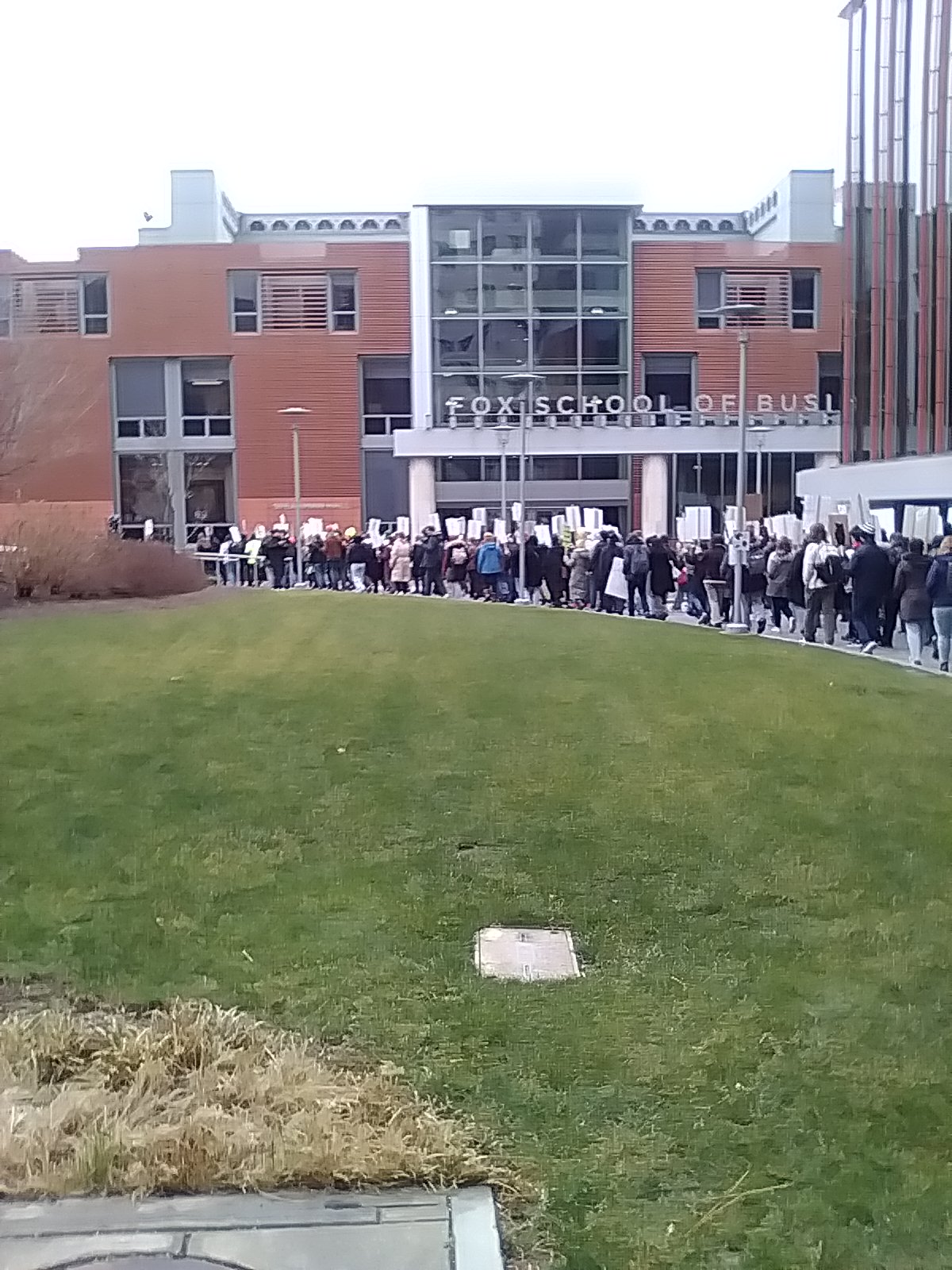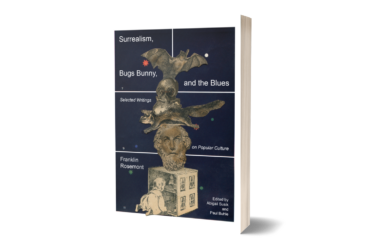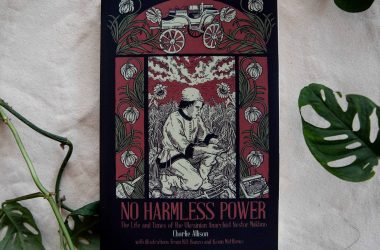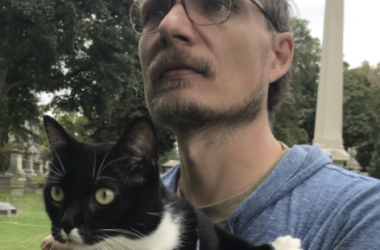THE SECOND WALKOUT AT TEMPLE, FEBRUARY 28TH
The second Temple University student walkout in solidarity with the grad workers union (TUGSA) in February drew hundreds despite it being a cloudy and overcast day.
People holding signs from the CUNY system were there, as was a representative of the faculty union, the student workers union, organizers from Socialist Alternative and others gathered under the bell-tower.
People eat food ordered from Chipotle, place coats on benches so as to not get soaked before the march.
There are Temple PD around the edges of the crowd. Historically, police and unionized workers have been on opposite sides of the barricades. That is still true, however in this case the Temple PD, at least, have reasons to be sympathetic to the strike and very pissed at Temple admin. According to PhillyCrimeUpdate, the fatal shooting of a Temple PD officer in February came after the cancellation of the overtime PPD patrols used to support TUPD officers and the removal of handheld TUPD radios from the PPD 22nd district by Temple’s vice president of public safety, Jennifer Griffin. The shooting sent Temple into a flurry of billboards, fundraising and desperately trying to further launder its already oil-slick quality reputation.
During both walkouts, I saw people in yellow jackets in passing cars—the uniform of both Temple PD and Allied Barton unarmed security guards—waving and honking in support as TUGSA and the students and their allies marched down Broad Street and held a pointed open-mic in front of Sullivan Hall.
A source in TUGSA told me that so unnerved were the administrators by this show of collective power that they have been resistant to holding negotiations on campus, and complaining in meetings about the picketing.
Back in the present, orators address the eager crowd over a microphone and loudspeakers. Steve Newman, former head of the faculty union, a grey-haired fellow, spoke to enthusiastic applause. He pointed out that already, USPS teamsters are flat out refusing to deliver packages to Temple in the spirit of solidarity. He then went on to say that he had personally hand-delivered the signatures of hundreds of faculty members to Temple president Jason Wingard demanding he cease retaliation against the striking workers.
Since January 31st, when TUGSA went on strike, Temple has tried the following tactics, all about as subtle as a brick in the teeth:
* Cancelling student tuition remission and giving the striking workers until March 9th to pay off tens of thousands of dollars that they suddenly owe—failure to pay means, according to Temple, being banned from continuing to take classes needed to graduate from the University.
* Not-so-subtly threatening workers with visas with deportation
* Before the first walkout in February, Chief Operating Officer Ken Kaiser wrote an email composed entirely of corporate double-speak, imploring students and workers to please please not join the walkout, won’t someone think of the children their personal goals and not join this horrible, disruptive strike. That’s the subtext, so loud it might as well be text.
* Cancelling the health insurance of the striking workers (such was Temple admin’s ineptitude that people uninvolved with union or strike were also booted)
* Hiring unqualified workers (basically, scabs: anyone with a secondary degree that can fog a mirror) to teach the classes that the striking workers refuse to teach—for example, the hiring of a realtor to teach English 101.
* Even worse: Temple knowingly hired a Nazi to teach a scabbed Greek philosophy class. It fell to TUGSA to clean up this mess and contact the deans directly, resulting in the Nazi being fired. Clearly TUGSA cares more about Temple University than Temple University itself does.
* To top this off, Temple proves to be very open handed when trying to break the back of organized labor—paying scabs more to teach one semester than they pay to the TA’s and RA’s that make up TUGSA in a year.
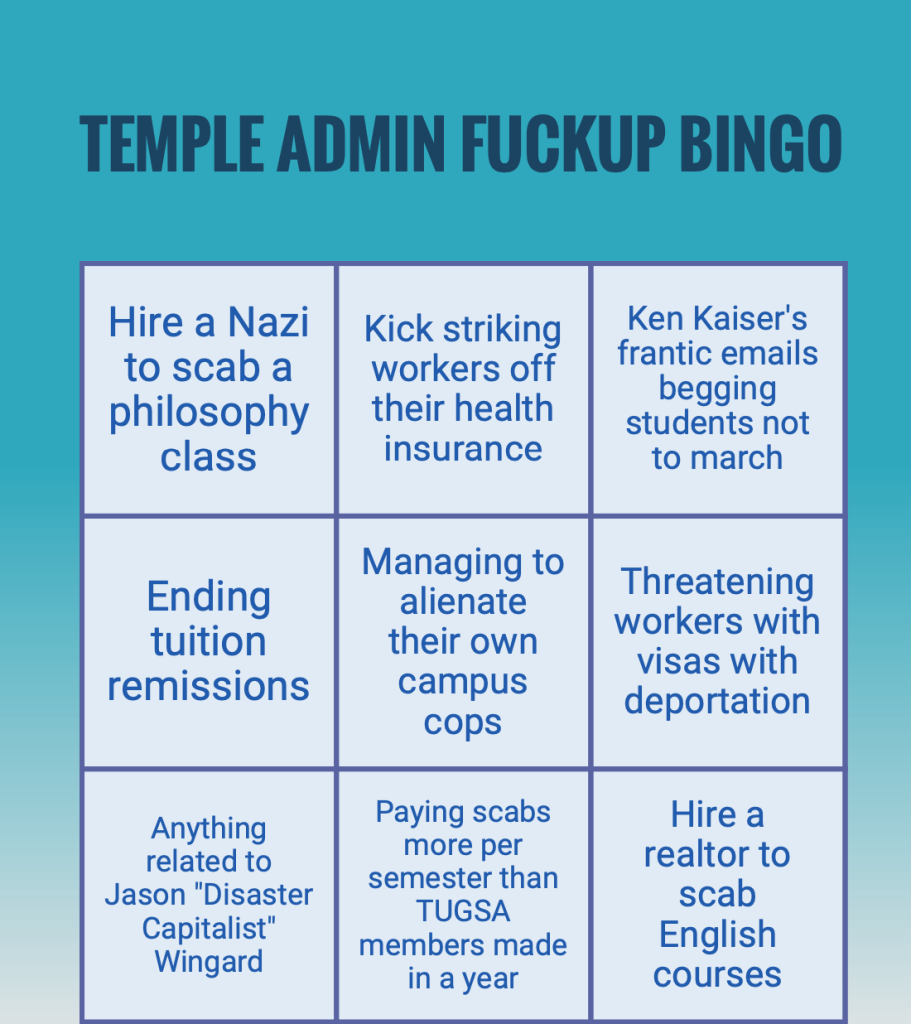
The next speaker was a member of the student union—the students who organized on their own these walkouts, in parallel to TUGSA’s efforts. They pointed out that while every Temple employee in a union had signed a strike with an anti-solidarity clause, there was nothing preventing said workers and students from staging a sickout. The goal is to shut campus down if the strike continues. This also met with wild applause and whistles.
The speaker added that the West Virginia teachers unions had waged illegal strikes and won—a tactful hint that a localized general strike focused on Temple was now far more possible than it had seemed on January 31st.
Then the speaking was over and it was time for marching. We—union members, students, faculty, allies—gathered up our masks, our noise-makers, and the signs TUGSA had made and marched. I’m happy to report that TUGSA ran out of their bright signs before it ran out of marchers—many had brought their own handmade ones (my personal favorite: “A Realtor Is Teaching My English Class Right Now.”).
One falls into a rhythm while marching. TUGSA understands the value of music in building energy and solidarity—recorded playlists on speakers and iPhones were and are mainstays of their pickets. As the strike has worn on, TUGSA members and supporters have showed up with instruments—a drum set, a saxophone, a clarinet. It is hard to imagine the daily picket lines marching without music, and this second walkout rally’s march rose to the occasion.
On approach to Sullivan Hall, home of the administrators, I have the great fortune to be just in front of a maestro with the much maligned and noble kazoo. But that mild irritation fades as the hundreds-strong march of protestors completes its first circuit of the Gothic-inspired hall. By going through the narrow alley between it and its neighbors, the strikers and their musicians take advantage of the acoustic effects of being between two narrow stone buildings. Electronic speakers would have been quieter. They played in accompaniment to by now classic TUGSA chants:
Speaker (bullhorn): If we don’t get it—
ALL: SHUT. IT. DOWN.
Speaker: What do we want?
ALL: A LIVING WAGE
Speaker: WHEN DO WE WANT IT?
ALL: NOW!
Speaker: What’s dis-guuuusting?
ALL: UNION-BUSTING
Speaker: What’s dis-guuuuuusting?
ALL: UNION BUSTING
Speaker: “Who’s a core function?”
ALL: “WE’RE A CORE FUNCTION!”
Speaker: “Who’s out-standing?”
ALL: “WE’RE OUTSTANDING!”
This time, the lights of Sullivan remained on throughout the orbits of the striking workers. Last time a walkout march came this way, a fortnight ago, the administrators shut off their lights like children hiding under the covers from the boogeyman, an illusion of safety spoiled when some unthinking administrator or other by reflex turned on the lights. Whoops, someone was at home after all.
After many turns around Sullivan Hall, the march went down Broad Street. When one marches with hundreds—rather than dozens—the cluster of thirty to fifty people closest to you determines the pace and what chants are sung. If one is moving between sections, one can be caught between chants. This didn’t matter so much on Broad Street—one could barely think for the cars honking in support for the strike. Looping back through the campus, we entered the home stretch.
My absolute favorite chant, I must mention, came at the end of the march, from the head of the column:
Speaker(bullhorn): “Where iiiis Wingard?”
ALL: “BEEEEING AAAA COWARD!”
It’s unclear if Wingard heard these accurate descriptions of his character, but some days later it was brought to his attention that TAUP has entered into discussion about holding a vote of no-confidence in Jason Wingard and other top administration officials. The last time a no-confidence vote happened in 2016, the officials in question left Temple in disgrace.
If TAUP proceeds, I wouldn’t bet against their vote achieving similar success. Wingard’s leadership has proved so cartoonishly villainous that he is nearly impossible to find sufficient invective for. The most concise way may be this:
President Wingard is a disaster capitalist.
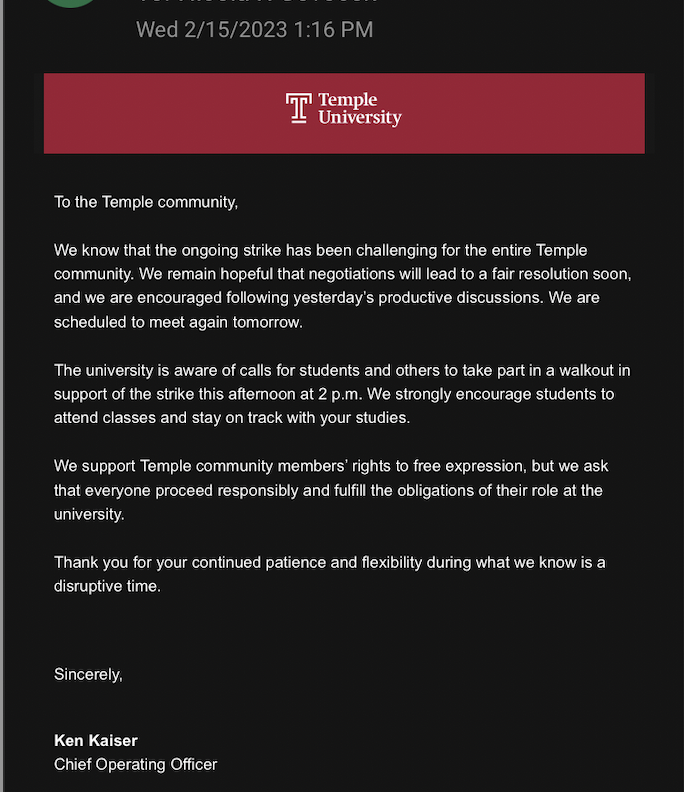
To Jason Wingard, the corporatization of the American university is an essential step to extract profit from students, faculty and staff to enrich himself and the private equity mollusk, as Matt Seybold puts it in his excellent article in the LA Review of Books.
There is a feedback loop in all this: what makes money must be good, and good must be what makes money—by this tautology, Jason Wingard and his ilk set their north-star.
A recent column for CNN compared Wingard’s deliberate sabotage of ‘his’ university’s workers, resources and reputation to the 1892 Homestead Stand in Pennsylvania where Carnegie and Frick sent in Pinkertons to break a steel strike that concluded with a massacre of the workers and greatly impaired union organizing power in the last days of the 19th century.
To put it more bluntly: Wingard’s ham-handed attempts to crush the union are hardly without precedent in American history. In fact, this sort of blatant marshaling of force is the rule rather the exception.
On learning of the unrest, Wingard issued a statement that, while rich in letters, was steeply in the negatives when it came to such things as meaning, information, or the pale flitting ghost of even the shallowest apology. ”Moving forward, the entire leadership team and I are committed to continue listening to an communicating with all our communities, and I ask for both your understanding and grace as we work together to navigate the university through this uncertain time,” Wingard wrote. “Temple Proud is something we all are, even when times are tough.”
Of course, the definition of ‘Temple Proud’ Wingard so callously invokes must look pretty different to a former Goldman Sachs University head and millionaire compared to Temple workers who have to depend on food stamps to survive. Wingard presumably is proud of running a (up to now) successful grift for private equity atop of a R1 university–the TUGSA strikers will have cause to be Temple Proud if they get a fair contract and Wingard is driven out in disgrace.
The walkout march ended back at the bell tower. The clouds had begun to lift.
When I walked home from the second walkout, a school bus honked at me and a not a few people waved. I was wearing a pair of TUGSA pins.
The people of Philadelphia, broadly, are behind the TUGSA strike.
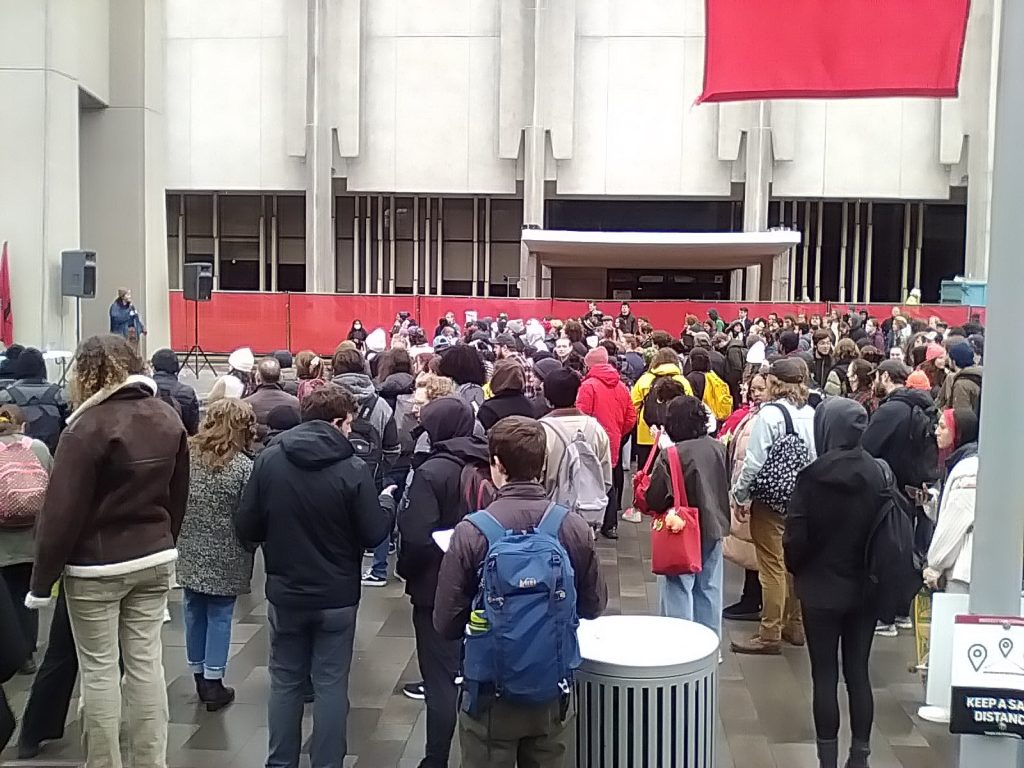
May it succeed!

